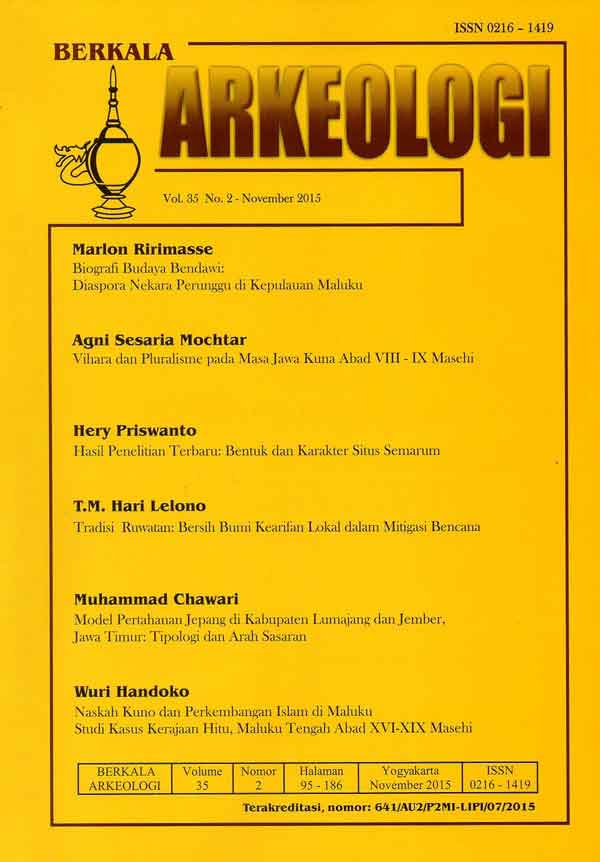VIHARA DAN PLURALISME PADA MASA JAWA KUNA ABAD VIII - XI MASEHI (TINJAUAN DATA PRASASTI)
Main Article Content
Abstract
The era of reformation in Indonesia was supposedly articulated with the pluralism of the society. Sadly, many cases regarding religious and ethnic conflicts pronounced the opposite, whereas pluralism and religious tolerance were two of the main characters of the nation since the days of the ancestors. The legacy of those two characters is actually able to be observed through cultural heritage, as a messenger from the past. This study examines one aspect of the practice of religious tolerance, which recorded in the ancient inscriptions from 8th to 11th AD., which selected through purposive sampling procedure. The aforementioned aspect was regarding the important role of ancient vihÄra as a symbol of religious tolerance in society. Such role was the impact of its functions, which are different with today’s modern function. This information on the function and role of the vihÄra in ancient Java is provided to support modern Indonesian society to understand their material cultural heritage.
Article Details

This work is licensed under a Creative Commons Attribution-NonCommercial-ShareAlike 4.0 International License.
References
Brandes, J.L.A. 1913. ‘Oud Javaansche Oorkonden, Nagelaten Transcriptiesâ€. VBG LX. Batavia : Albrecht & Co.
Boechari. 1985. Prasasti Koleksi Museum Nasional Jilid 1. Jakarta : Proyek Pengembangan Museum Nasional.
de Casparis, J.G. 1956. Selected Inscriptions From The 7th to The 9th CenturyA.D. (Prasasti Indonesia II). Bandung : Masa Baru.
Christie, Jan Wisseman. 2000. Register of The Inscription of Java Part 1: 732 to898 A.D.
____________________ 2002. Register of The Inscriptions of Java Part 2: May 855 – May 898 A.D.
____________________ 2004. Register of The Inscriptions of Java Part 3: May 898 – May 929 A.D.
Chodron, Thubten. 1995. Tradisi dan Harmoni: Menelusuri Jejak-jejak Agama Budha. Bandung: Yayasan Penerbit Kanariya.
Damais, L.C. 1952. ‘Études D’épigraphie Indonésienne. III – Liste Des Principales Inscriptions Datées de L’Indonésie’. Dalam BEFEO Tome XLVI.
___________ 1995. ‘Agama Budha di Indonesia’. Epigrafi dan Sejarah Nusantara: Pilihan Karangan Louis-Charles Damais. Jakarta: EFEO.
Darmosoetopo, Riboet. 1971. Prasasti Salimar IV. Skripsi Sarjana. Yogyakarta: Fakultas Sastra dan Kebudayaan Univeristas Gadjah Mada.
__________________ 2003. Sima dan Bangunan Keagamaan di Jawa Abad IXXTU. Yogyakarta: Prana Pena.
Degroot, Véronique. 2006. ‘The Archaeological Remains of Ratuboko : From Sri Lankan Buddhism to Hinduism’. Dalam Indonesia and The Malay WorldVol. 34 No. 98 : 55-74.
Griffiths, Arlo. 2014. ‘Early Indic Inscriptions of Southeast Asia’. Dalam Lost Kingdoms: Hindu-Buddhist Sculpture of Early Southeast Asia. New York: Metropolitan Museum of Art. Hlm 53-57.
Groeneveldt, W.P. 1960. Historical Notes on Indonesia and Malaya Compiled From Chinese Sources. Jakarta : C.V. Bhratara
Guy, John. 2014. ‘Introducing Early Southeast Asia’. Dalam Lost Kingdoms: Hindu-Buddhist Sculpture of Early Southeast Asia. New York: Metropolitan Museum of Art. Hlm. 3-13.
Indradjaja, Agustijanto. 2005. ‘Awal Persentuhan Agama Buddha di Daerah Pantai Utara Jawa Barat (Kompleks Percandian Batujaya)’. Dalam Religi dalam Dinamika Masyarakat : 45-59.
Kandahjaya, Hudaya. 2004. ‘A Study of The Origin and Significance of
Borobudur’. Disertasi. California : Berkeley University.
Kompas.com. 2013. Terduga Pelaku Peledakan Vihara Ekayana Ditangkap. (http://nasional.kompas.com/read/2013/12/16/1219099/Terduga.Pelaku.Peledakan.Vihara.Ekayana.Ditangkap, diakses tanggal 1 November 2014).
Kompas.com. 2014. Mengapa Teroris Incar Wihara (http://nasional.kompas.com/read/2014/01/02/195058/Mengapa.Teroris.Incar.Wihara. diakses tanggal 6 November 2014).
Kusen. 1989. ‘Faktor-faktor Penyebab Terjadinya Perubahan Status Sawah di Wanua Tengah Dalam Masa Pemerintahan Raja-Raja Mataram Kuna Abad8-10’. Laporan Penelitian. Yogyakarta: Fakultas Sastra Universitas Gadjah Mada.
Louis, Frederic. 1995. Buddhism. Paris: Flammarion.
Manguin, Pierre-Yves dan Agustijanto Indradjaja. 2011. ‘The Batujaya Site: New Evidence of Early Indian Influence in West Java’. Dalam Pierre-Yves Manguin, A. Mani dan Geoff Wade (ed.)
Early Interactions Between South and Southeast Asia: Reflections on Cross Cultural Exchange. Singapore: Institute of Southeast Asian Studies.
Miksic, John N. 1994. ‘Double Meditation Platforms at Anuradhapura and The Pendopo of Ratu Boko’. Dalam Saraswati : Esai-esai Arkeologi 2.KALPATARU Majalah Arkeologi No.10 : 23-31. Jakarta : Puslitarkenas.
Mochtar, Agni Sesaria. 2009. ‘Vihara Pada Masa Jawa Kuna Abad VIII-XI M (Tinjauan Data Prasasti)’. SKRIPSI SARJANA. Yogyakarta. Fakultas Ilmu Budaya-Universitas Gadjah Mada.
Pinardi, Slamet. 1984. ‘Data Sementara Bangunan Kompleks Pendapa Kraton Ratu Baka’. Dalam Berkala Arkeologi V (2). Yogyakarta : Balai Arkeologi Yogyakarta.
Prajudi, Rahadhian. 1999. Kajian Tipo-Morfologi Arsitektur Candi di Jawa. Tesis Magister Program Studi Arsitektur. Bandung: Program Pasca Sarjana Institut Teknologi Bandung.
Robinson, Richard dan Willard Johnson. 1977. The Buddhist Religion: a Historical Introduction Second Edition. Massachusetts: Duxbury Press.
Sankalia, Hasmukh D. 1934. The University of Nalanda. Madras : B.G. Paul &Co. 132 Berkala Arkeologi Vol.35 Edisi No.2 November 2015: 117-132
Sarkar, Himanshu Bhusan. Sarkar, Himansu Bhusan. 1972. Corpus of The Inscriptions of Java : Corpus Inscriptionum Javanicarium up to 928 A.D. Calcuta : Firma K.L.Mukhopadhyay.
Soekmono. 1973. Sejarah Kebudayaan Indonesia Jilid II. Jakarta: Penerbit Kanisius.
_________ 1974. ‘Candi: Fungsi dan Pengertiannya’. Disertasi. Jakarta: Fakultas Sastra Universitas Indonesia
Soetanti, Ninie. 1996. ‘Analisis Prasasti’. Dalam PIA VII : 171-182. Jakarta: Puslitarkenas.
Sudjangi, H. 2002. Konflik Sosial Bernuansa Agama: Studi Kasus Kerusuhan di Ambon. Laporan Penelitian, Pusat Penelitian dan Pengembangan Kehidupan Beragama. Jakarta: Departemen Agama.
Sunberg, Jeffrey Roger. 2004. ‘The Wilderness Monks of The AbhayagirivihÄra and The Origins of Sino-Javanese esoteric Buddhism’. Dalam BKI CLX-I : 95-123. Koninklijk Instituut voor Taal-, Land- en Volkenkunde.
Tim Puslitbang Kehidupan Beragama. 2006. Studi Model Alternatif Penyelesaian Konflik Kasus Padang Sappa Kabupaten Luwu Provinsi Sulawesi Selatan. Laporan Penelitian, Pusat Penelitian dan Pengembangan Kehidupan Beragama. Jakarta: Departemen Agama.
Tim Peneliti. 2001. Hubungan Antar Agama: Sebuah Analisis Sosial Keagamaan. Laporan Penelitian, Pusat Penelitian dan Pengembangan Agama dan Diklat Keagamaan. Yogyakarta: UIN Sunan Kalijaga.
Utomo, Bambang Budi. 2007. ‘Budha dan Sangha di Nusantara Pada Abad ke-9- 13 M.’ Dalam Archaeology Goes to Mall, Jejak Peradaban Nusantara Abad 9 Sampai Dengan 13. Maha Karmawibhangga: Warisan Tersembunyi di Kaki Borobudur : 10-23. Jakarta : Puslitarkenas.
Zoetmoelder, P.J. 2004. Kamus Jawa Kuna-Indonesia. Jakarta : PT. Gramedia.

